
There is some question if the “Huron Bay Terminus Railway” actually existed as an entity. For sure there was a 36″ tramway which served the slate mining efforts around Arvon in Michigan’s Upper Peninsula. The tramway had a dock which jutted out into Huron Bay and there was a slate mining operation named “Huron Bay Slate Company”. Even so the only mention that this tramway was named the “Huron Bay Terminus Railway” is a University of Michigan, Bentley Historical Library photo dated 1885 (ca.) with the caption “Huron Bay terminus railway from Michigan Slate Company quarries about 10 miles from L’Anse”. This original of the image can be found at https://quod.lib.umich.edu/b/bhl/x-bl005722/bl005722?fbclid=IwAR0EDZUiUc2PNDCKBoaZUUX1MdlH_y8L2IrqZht6o-tHS9b7bP_7edhHVXo. The image does not contain any other information to assist with the origins or history around the image. Even so, the photo is the only one known to exist which shows the dock or the locomotive which served the slate mines and the company town of Arvon Station in Michigan’s upper peninsula.
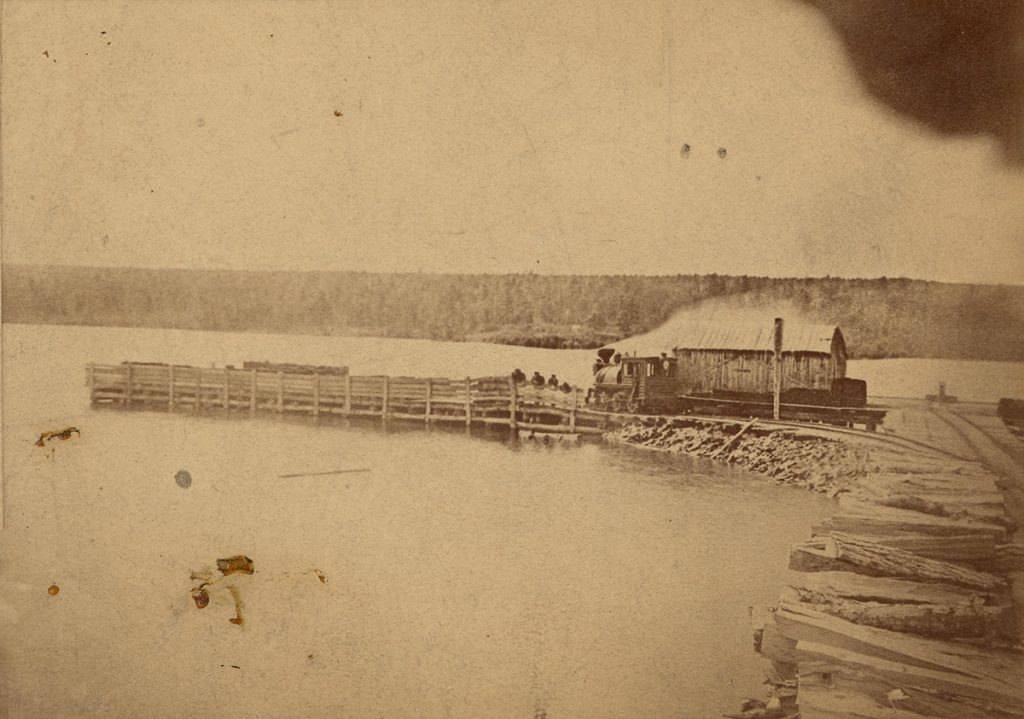
Slate Mining in Upper Michigan
During the post Civil War period, slate was popular as a roofing material for large municipal and private construction projects. The supply of slate could be problematic for some areas as most commercial supplies (or what was considered the best supplies) came from Pennsylvania, Maryland, Vermont and New York. Transport of heavy slate tiles over great distances was expensive and lower cost local supplies were sought after. When found, the slate of Baraga County in Michigan was found to be of high quality equal to that of the eastern regions. There appeared to be large quantities which could satisfy demand and last for many years. Although Baraga County was quite remote, it did have its disposal a deep water harbor with connections to the quickly growing cities of Detroit, Chicago and Cleveland to name a few.
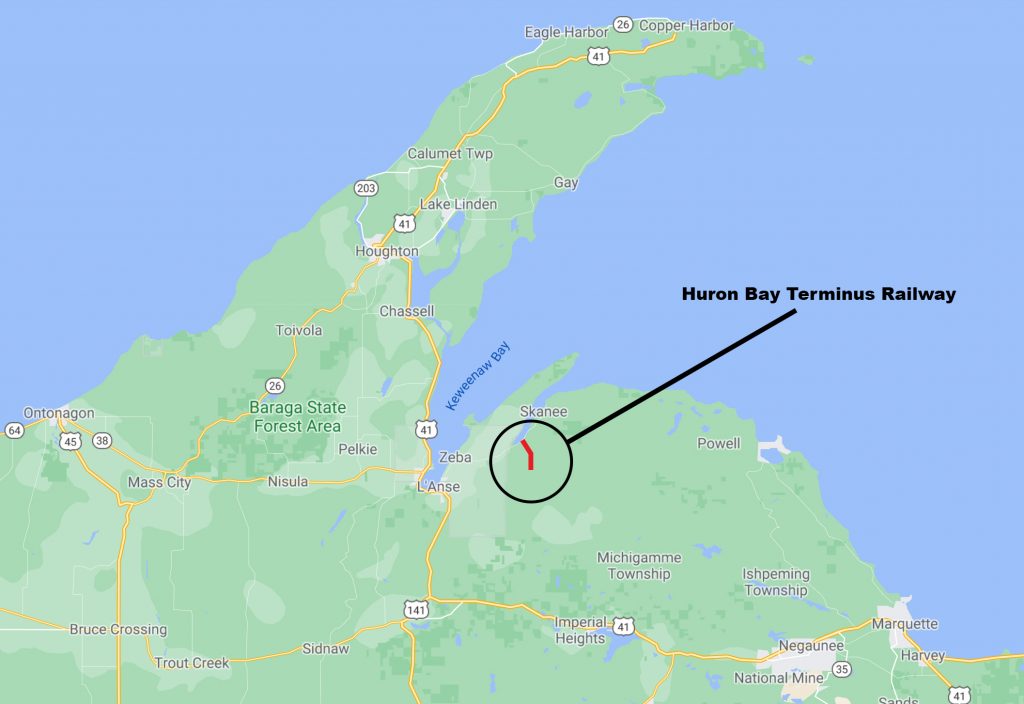
Commercial slate mining in Baraga County Michigan began around 1872 with the formation of the Huron Bay Slate and Iron Company and the Clinton Slate Company in 1874 less than 2,00 feet to the southwest of the Huron Bay locations. According to records of the time, in 1873 when slate shipments started a 3 foot tram road was used to transport the finished slate, 4.5 miles to a 600 foot dock on Huron Bay. In 1874 the tramway was extended to serve the Clinton site. The early reports do not mention the motive power or equipment used.
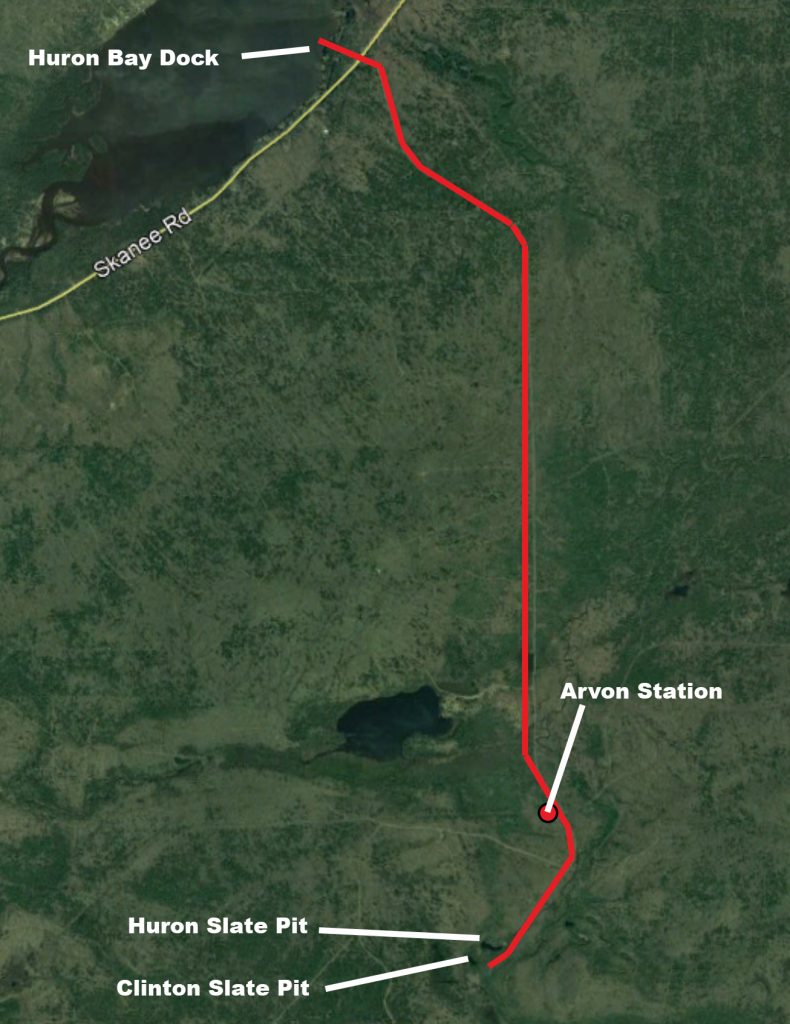
A company town was built a short distance from the mining location and Named “Arvon Station”. The tram would pass through Arvon Station on its way from the mining pits to Huron Bay. Period witnesses report that people would ride the train down to the bay. One report indicates that 15 people once crowded into the cab of the locomotive to avoid a downpour. Further reports indicate the ride was so rough, that one women “lost her lunch in an Atlantic fashion” during a ride to the bay.
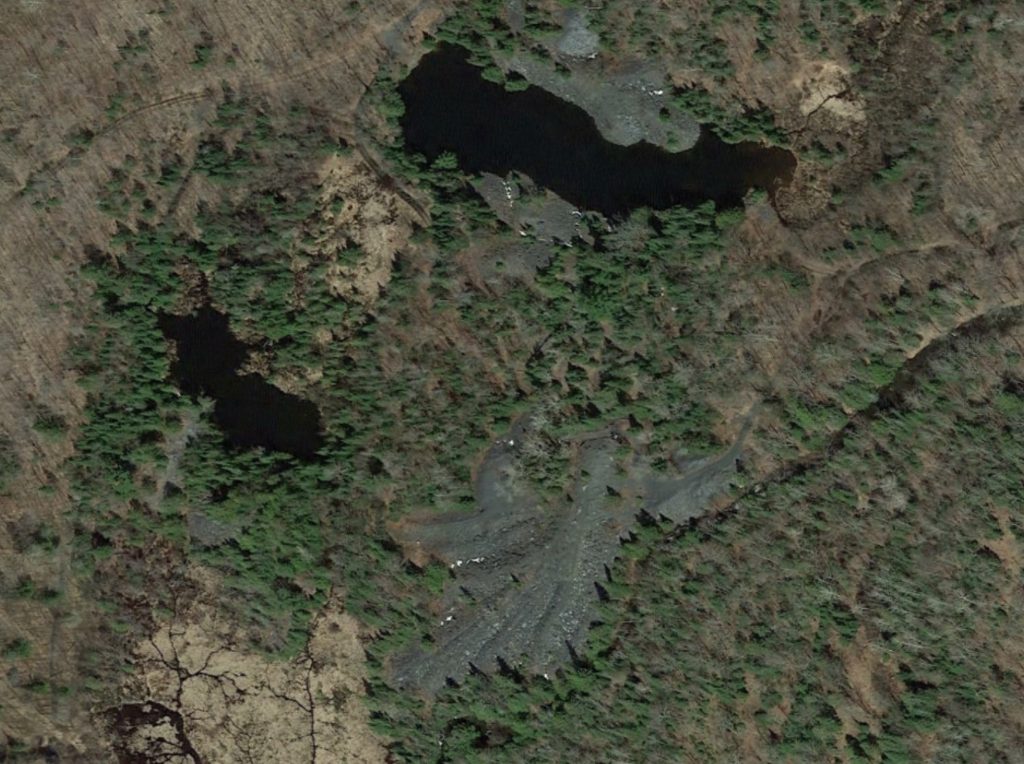
Contracts for slate were quickly won with the promise of cheap shipping from the deep harbor at Huron Bay to ports around the Great Lakes. It is rumored that after the Great Chicago Fire, many rebuilding projects there used (or intended to use) slate from Baraga County. Unfortunately with the Panic of 1873, the subsequent depression and possible poor management, both enterprises were in complete ruin by the end of the decade.
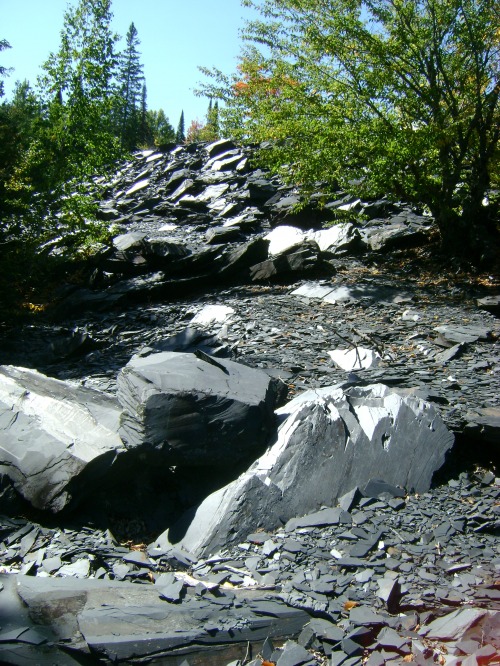
In 1881 the property owned by the Huron Bay Slate and Iron Company, the Clinton Slate and Iron Company, and the Superior Slate and Mining Company (no information is available as to where or when this operation started), was purchased re-organized as the Michigan Slate Company. The new company began work at the quarry in the fall of 1881.
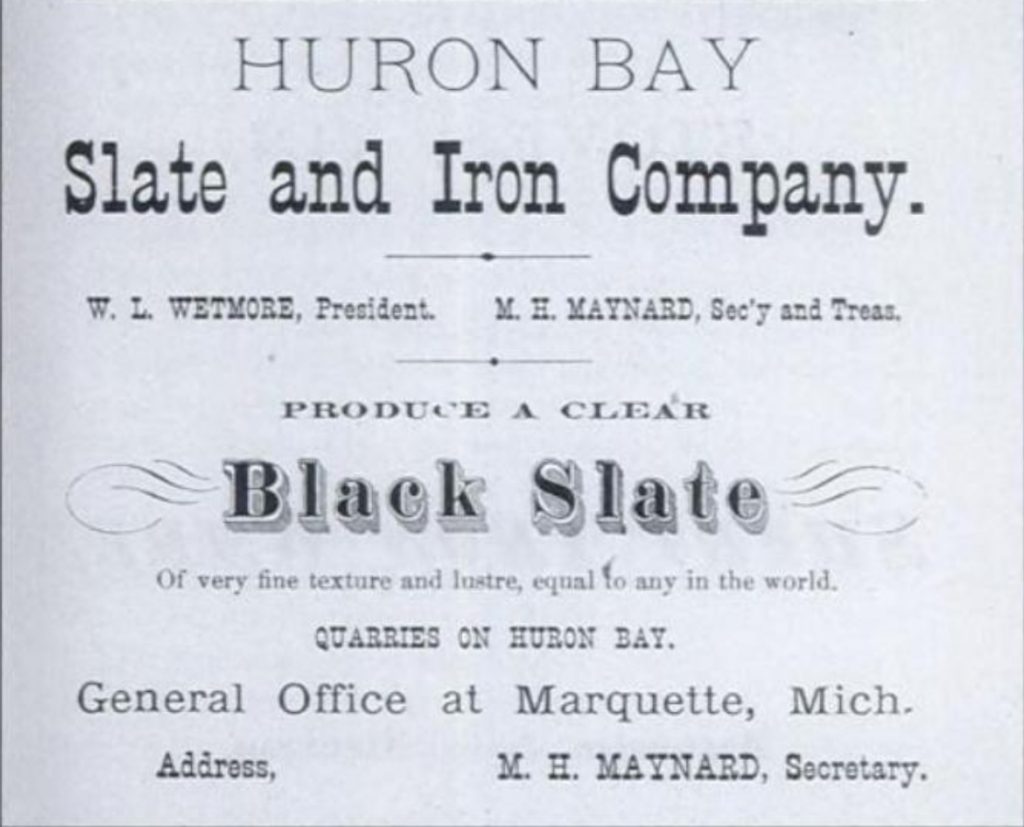
The new company built a new stone engine-house with a seventy-five horse-power engine for hoisting and pumping. They also build a small saw-mill for the timber and lumber required for repairing buildings and erecting new ones. The quarry operations were updated with new tools and equipment as well. The tramway was overhauled and repaired with heavier rail and the dock was also rebuilt. All of these updates were in anticipation of new contracts from places like the new Texas State capitol building and a new University Library building at Ann Arbor.
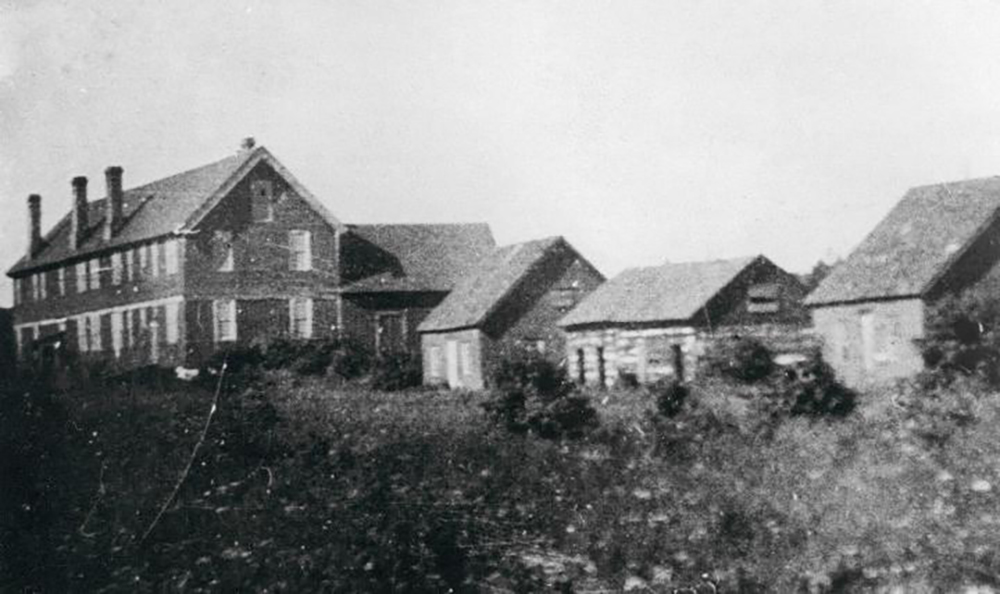
The slate industry for Michigan never did prosper as expected. In the ANNUAL REPORT OF THE COMMISSIONER OF MINERAL STATISTICS OF THE STATE OF MICHIGAN, FOR 1884, the Michigan Slate Company is described as “gradually enlarging its operations, and continues to produce a fair amount of the very best roofing slates. As the pits are enlarged the product is increased, but the enlargement is necessarily slow, and it will take time to bring the quarries up to the maximum production of which they are capable.” The fact is that the slate business never did grow into what the investors had hoped. By the time the Iron Range and Huron Bay Railroad used the old tram roadbed for its own right-of-way the slate business had pretty much slowed to a crawl.
The coming of the IR&HB would mean the end of the slate mining in the area. The IR&HB was known as the Million Dollar railroad. That’s what it took to build and it never ran a single train. With the Panic of 1893, poor management and its the chief engineer, fleeing to Mexico to escape allegations of fraud, the state eventually took possession of the right-of-way and other property as compensation for unpaid taxes. It is worth noting that one of the investors in the IR&HB was also one of the owners of the Michigan Slate Company. It appears the right-of-way and access to Huron Bay may have paid for the stock but also doomed his business once and for all.
Route to the Bay
The tramway traversed 4.5 miles when built. Some reports say the distance was 6 miles (possibly because of the additions to service the Clinton pit). The line ran downhill to the bay and it was reported during the construction of the IR&HB that the grade from the cut to the bay was in excess of 8%. I believe this excessive grade occurred before the IR&HB reached the Slate River and the tramway grade. There was approximately 6-8 miles from the cut until the line met with the tram grade and the cut is at a significantly higher elevation. The small 0-6-0T locomotive would not have been able to deal with such a tremendous grade for almost 20 years. The slate pits were at an elevation 1,150 feet while the bay sits at 601 feet. With a traverse of 4.5 miles that is equal to a grade of 2.3% overall. It is very likely the max grade in this area was between 3% and 4% overall.
A common practice for tram railways operating on hills is to have a switchback or Y near the water. The purpose was two fold; while on the hill, the locomotive should be on the down side of the hill and the cars should be pushed onto the dock. The locomotive on the downside minimizes the chance of a run-away but this places the locomotive on the wrong end of the train. It is possible to have a siding/run-around track at the bay end but using a switch back is cheaper, requiring less track, less time for switching and assists with sharp change of elevation at waterside.
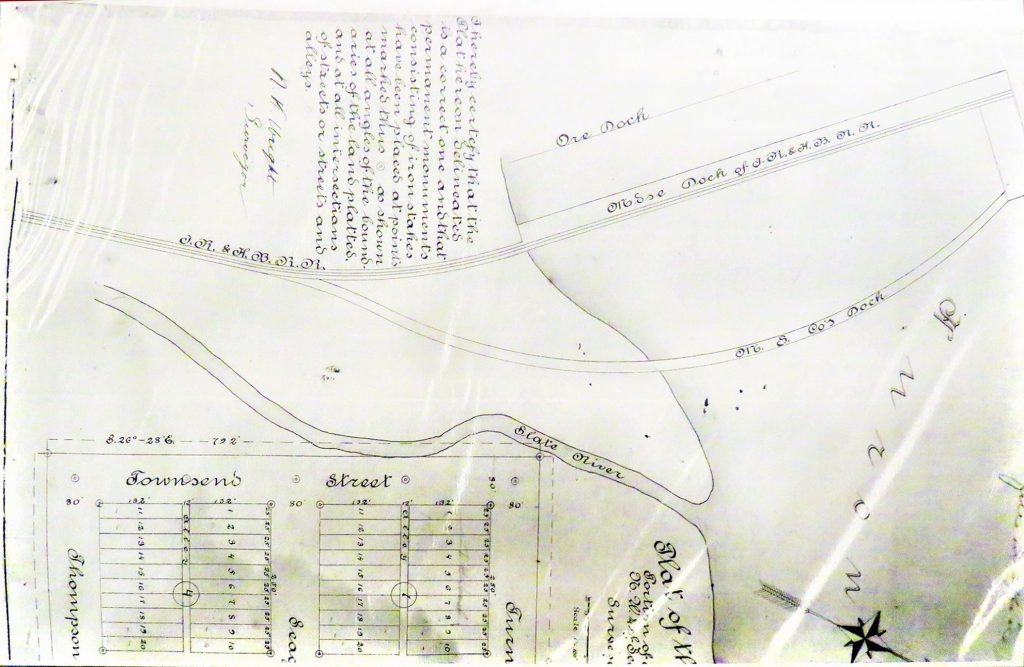
The dock was known to be an L shape in the bay according to drawings when the IR&HB ore dock was built. The photo of the dock confirms this. What is interesting is the rock fill and the building on the pier. One can only wonder what the men on the dock are looking at. Perhaps watching the fish and wishing they had their tackle.
Modeling the Huron Bay Terminus Railway
The image of the little 0-6-0T locomotive was from 1885 (assuming that date is correct) so by this time, the Michigan Slate Company was in operation. An 0-6-0T narrow gauge locomotive in one of the common scales is not readily available that I know of. I am sure one could be bashed from either an N scale or HO scale mechanism into HOn30 or On30. Although the gauge would be a little different from the prototype 36″, the feel would work just fine.
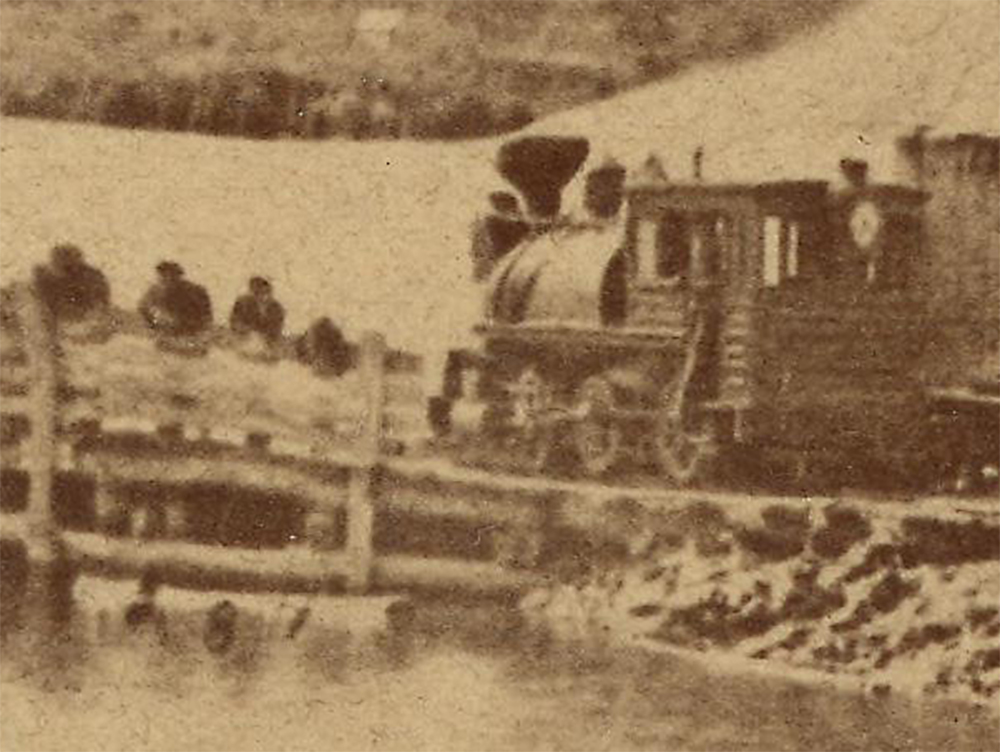
The key scenes are the mining pits/slate prep building and the dock. Either would make a great subject for a micro layout. Both ends could be modeled as “book ends” with trees/scenery hiding the short distance between. Even a short two sided layout would keep the scenes separate and provide for operations.
The name Huron Bay Terminus Railway would make sense when the line served both the Huron and Clinton sites. Since this is not a railroad that interchanges, there would not be much lettering on rolling stock or the locomotive.
Tram/industrial railways are not well documented or preserved as they were part of the industry they served. As a result, photographs and drawings are hard to come by. This is just one small example of a little railroad that was lost to time.

Hi Marshal. Very interesting and well written article.
This is a great article (which I just discovered). H.K Porter Company records show a 36 inch gauge 0-6-0T locomotive (construction number 585) with 10″ by 16″ cylinders was delivered in August 1883 to the Michigan Slate Company of Lansing, Michigan (which is where the company incorporated. The locomotive was probably shipped directly to the mine site in Baraga County).
A GREAT POST ON AN OPERATION I WAS UNAWARE OF! 😀
Very interesting. My dad grew up in Skanee, my grandfather ordered their house from a catalog and had it shipped to L’anse. They lived on a piece of land at the corner of the Slate river and the Skanee road. My great great grandparents had a general store in L’anse. My brother and I grew up playing as kids in the slate quarries and on the beaches of Huron Bay all through the 80’s. We would take grandpa in our van for a ride up the Arvon road (the former railroad grade) and he would show us where all the town of Arvon buildings used to be when he was a kid. Grandpa always told the story that the first locomotive came down the grade and went clean off the end of the dock into the bay, there is nothing I’ve ever read to confirm that however. My grandfather was the Arvon Township Supervisor from 1938-42. Thanks for posting this, excellent article.
If you are on Facebook, I really suggest you tell the story to the people on the Iron Range & Huron Bay Railroad Group (https://www.facebook.com/groups/674535449720618). There are many conflicting stories about the locomotive coming off the tracks. Many believe it never did as the stories conflict so much!
I was recently at the rock cut and noticed some light gauge rail exposed there. What would that have been for? IR&HB supposedly sold all the rail.
Although reports from the time say that say the rail was salvaged, it has been verified, that some rail in the rock cut was from the original IR&HB. This was verified by checking the markings on the rail. It showed a manufacture date that coincided with the building of the road.
Many of the reports about the IR&HB have been to be shown to be less than accurate. The Iron Range & Huron Bay Railroad Group on FB (https://www.facebook.com/groups/674535449720618) has a wealth of information about the line and many enthusiasts post their findings there. I highly suggest joining that group if you have interest in the railroad.
Thanks. Indie some more research last night and it looks like they might’ve installed some lighter gauge rail along the length of the line for the equipment utilized to salvage the larger rail to run in. They probably abandoned that after the salvage effort of the larger rail. I joined the suggested FB group last night. Thanks!
This would be perfect for a bike trail.